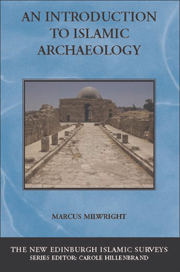Book contents
- Frontmatter
- Contents
- List of figures
- Acknowledgements
- Notes on transliteration and dating
- List of abbreviations
- 1 Introduction
- 2 Early Islam and late antiquity
- 3 New directions in the early Islamic period
- 4 The countryside
- 5 Towns, cities and palaces
- 6 Religious practice in the Islamic world
- 7 Crafts and industry
- 8 Travel and trade
- 9 The ‘post-medieval’ Islamic world
- 10 Conclusion
- Glossary
- Dynasties and periods
- Bibliography
- Index
6 - Religious practice in the Islamic world
Published online by Cambridge University Press: 05 August 2013
- Frontmatter
- Contents
- List of figures
- Acknowledgements
- Notes on transliteration and dating
- List of abbreviations
- 1 Introduction
- 2 Early Islam and late antiquity
- 3 New directions in the early Islamic period
- 4 The countryside
- 5 Towns, cities and palaces
- 6 Religious practice in the Islamic world
- 7 Crafts and industry
- 8 Travel and trade
- 9 The ‘post-medieval’ Islamic world
- 10 Conclusion
- Glossary
- Dynasties and periods
- Bibliography
- Index
Summary
Belief and ritual practice have had a profound impact upon the material culture of the Islamic world. Muslim religious invocations and sections taken from the Qur'an appear on documents, monumental inscriptions and coins during the seventh century (chapter 2). The placement of Qur'anic passages on coins ensured their wide circulation among Muslims and non-Muslims alike. While the precise content of such epigraphic coins would have eluded the illiterate user, it is conceivable that the more general significance of the text would have been appreciated by the wider populace. Certainly the fascination with script (both as a carrier of information and as an object of aesthetic appreciation) becomes a defining characteristic of Islamic visual culture, and is evident also in artefacts recovered during excavations and surveys. Confronted by the conspicuous place of religious architecture in the urban landscape of late antiquity, Islamic authorities devoted great energy to the construction of congregational mosques (chapter 3). Other religious monuments – schools (madrasas), sufi convents (khanqahs), hospitals (maristans), and tomb complexes – transformed the towns and cities of the Islamic world from the tenth century onwards. The countryside, too, was populated with Muslim structures, including mosques, tombs, buildings associated with the hajj, and even free-standing minarets. Rural mosques ranged from substantial stone buildings to the dimunitive open-air (hypaethral) structures of the early Islamic period located in the Negev desert.
- Type
- Chapter
- Information
- An Introduction to Islamic Archaeology , pp. 124 - 142Publisher: Edinburgh University PressPrint publication year: 2010

